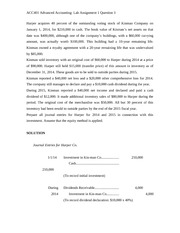
Activity-based costing (ABC) is a way to assign indirect manufacturing costs like overhead to products or processes. Though it quicken or quickbooks takes more work than applying a standard overhead rate, it generates more accurate cost estimates. It’s a form of accounting that tracks production costs in a way that managers can use to inform business decisions.
Raw materials used in production shows the cost of direct and indirect materials placed into the production process. Cost of goods manufactured represents the cost of goods completed and transferred out of work-in-process (WIP) inventory into finished goods inventory. Cost of goods sold represents the cost of goods that are sold and transferred out of finished goods inventory into cost of goods sold. This can result in drastically different figures for your business financials, which is why it’s important to use the right approach based on your specific business requirements.
The information provided through FundKite does not constitute legal, tax, financial or accounting advice, and should not be considered a substitute for obtaining competent personalized advice from a licensed professional. You should seek professional advice before making any decision that could affect the financial health of your business. Standard costing is very beneficial for creating and polishing budgets as it gives predefined cost estimates that can be measured against actual expenses.
Overhead Cost Assignment

By following quickbooks set up new company generally accepted accounting principles (GAAP) and using the right software for manufacturing, businesses can keep a close eye on their cash flow. This form of accounting ensures that every penny spent on producing a product is tracked, from the big stuff like direct labor costs to the smaller, often overlooked manufacturing overhead costs. Accounting systems are more complex for manufacturing companies because they need a system that tracks manufacturing costs throughout the production process to the point at which goods are sold.
Management Accounting
Also, costs may be assigned to specific jobs (known as job costing) and then charged to the cost of goods sold when the inventory items in those jobs are sold to customers. This is a costing method that differs from job costing in that it incorporates more indirect costs, such as resource consumption. It can help you hone which products are profitable and spot opportunities to drive better results for your existing products. A manufacturing company differs from a merchandising company in the reporting of the cost of the merchandise (goods) available for sale and sold during the period.
How does a manufacturing company report taxes?
- When tracking manufacturing expenditure, it’s important to understand both direct and indirect costs.
- In standard costing, businesses assign standard costs for raw materials and labor when factoring them into inventory and production expenses.
- Accurate financial records are important for both capital expansion goals and to avoid legal repercussions arising from monetary misappropriation.
- Manufacturing accounting involves tracking the cost of goods sold, production costs, the efficiency of the manufacturing process, and the margin of profit.
- If cash flow is a potential concern, addressing this constraint might involve securing manufacturing business funding beforehand to ensure it does not impede the overall production process in the facility.
Overhead costs include expenses like factory rent, utilities, and administrative costs. It helps facilitate analysis and efficiency refinement for businesses that revolve less around each unit and more around repetitive procedures. When you can estimate how much it’ll cost to produce each unit, you can gauge your progress during each accounting period.
In addition, they use the term net purchases instead of cost of goods manufactured and often include the schedule of cost of goods sold in the income statement rather than presenting it separately. The direct costs are often traceable to the creation of the product and the maintenance of low variability in the overheads allows businesses to ensure a healthy margin of profit. Financial accounting is primarily concerned with the creation of core financial statements such as cash flow reports, balance sheets, income reports, and profit statements. These documents are important when the manufacturing business needs to showcase its credibility and financial performance to investors or funding partners when raising capital. This form of accounting is also useful when the company undergoes regulatory checks and inspections.
The income statement for merchandising and manufacturing companies differs in the reporting of the cost of the merchandise (goods) available for sale and sold during the period. Of the total raw materials placed in production for the year, $12,000 was what is an ordinary annuity for indirect materials and must be deducted to find direct materials placed in production. By failing to record the inventory loss, Rite Aid overstated inventory (an asset) on the balance sheet by $9,000,000 and understated cost of goods sold (an expense) by $9,000,000 on the income statement. This ultimately increased profit by $9,000,000 because reported expenses were too low.
